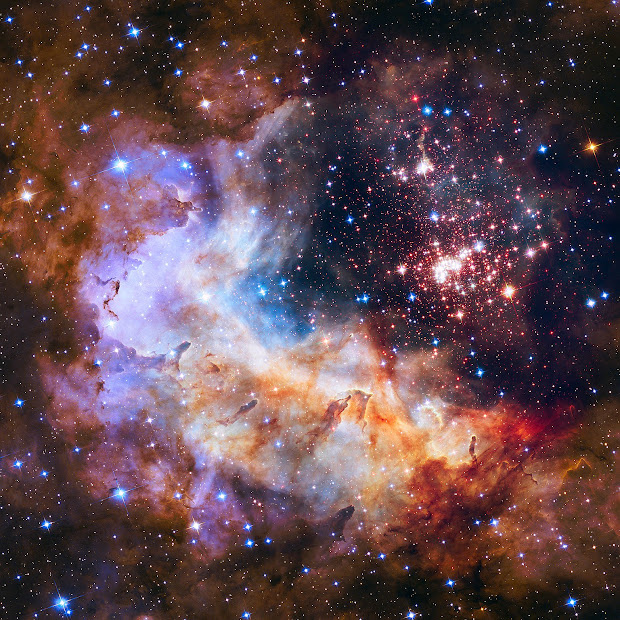Click on the image for full resolution (7.3 MB)
This Hubble Space Telescope image of the cluster Westerlund 2 and its surroundings has been released to celebrate Hubble's 25th year in orbit and a quarter of a century of new discoveries, stunning images and outstanding science. The image's central region, containing the star cluster, blends visible-light data taken by the Advanced Camera for Surveys and near-infrared exposures taken by the Wide Field Camera 3. The surrounding region is composed of visible-light observations taken by the Advanced Camera for Surveys. The stellar nursery is difficult to observe because it is surrounded by dust, but Hubble's Wide Field Camera 3 peered through the dusty veil in near-infrared light, giving astronomers a clear view of the cluster. Hubble's sharp vision resolves the dense concentration of stars in the central cluster, which measures only about 10 light-years across.
The giant star cluster is only about two million years old, but contains some of the brightest, hottest and most massive stars ever discovered. Some of the heftiest stars are carving deep cavities in the surrounding material by unleashing torrents of ultraviolet light and high speed streams of charged particles, known as stellar winds. These are etching away the enveloping hydrogen gas cloud in which the stars were born and are responsible for the weird and wonderful shapes of the clouds of gas and dust in the image. The pillars in the image are composed of dense gas and dust, and are resisting erosion from the fierce radiation and powerful winds. These gaseous monoliths are a few light-years tall and point to the central cluster. Other dense regions surround the pillars, including dark filaments of dust and gas. Besides sculpting the gaseous terrain, the brilliant stars can also help create a succeeding generation of offspring. When the stellar winds hit dense walls of gas, they create shocks, which generate a new wave of star birth along the wall of the cavity. The red dots scattered throughout the landscape are a rich population of forming stars that are still wrapped in their gas and dust cocoons. These stellar foetuses have not yet ignited the hydrogen in their cores to light-up as stars. However, Hubble's near-infrared vision allows astronomers to identify these fledglings. The brilliant blue stars seen throughout the image are mostly in the foreground.
Image Credit: NASA, ESA, the Hubble Heritage Team (STScI/AURA), A. Nota (ESA/STScI), and the Westerlund 2 Science Team
Image enhancement: Jean-Baptiste Faure










0 comment(s):
Post a Comment